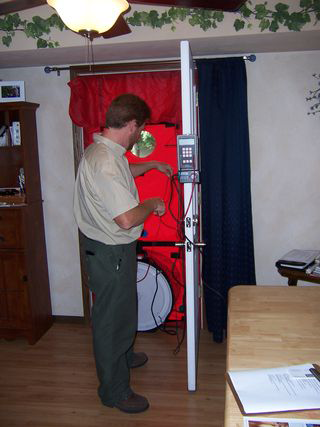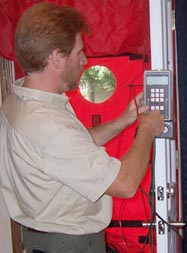
How can a home inspector or energy auditor use a Chimney Balloon to solve fireplace downdrafts?
Energy audit
Q: Jason, I have a wood burning fireplace with a cozy great heater insert. I have a top of the Chimney Balloon and traditional damper installed. I have bad downdrafts and soot smell on rainy, windy days.
I am a Home Inspector and I am in the middle of a Certified Energy Training Program with RESNET. I just received a copy of Energy Magazine and read about your product. Looks like a good idea. I am going to try the vinegar tip. I need to measure my flue and I will order to try on my house. Once I get my blower door I will try the test like you did. I have doors, 2 dampers, and the Chimney Balloon. Thanks.- MW
PS. I will tell all my clients if I have success with your product. Nice website by the way and I am posting it on a few inspection association boards for others to try.
A: Hi MW, That was a great article you were referring to in Home Energy magazine (Mar/Apr 09) the energy rater that did the testing of the Chimney Balloon (Mark Furst) for that article did a great summarizing his testing of the Chimney Balloon. Mark was chosen to do the review/test because he had no experience with the Chimney Balloon, and could give an unbiased opinion. Mark also has a great reputation in Wisconsin for being very thorough at energy rating. We cannot re-post the article for copyright reasons, but you can click here to see a PDF of a summary of the Chimney Balloon article.
We would really welcome your comments and test results if you decide to do your own blower door testing of the Chimney Balloon with your fireplace.
We have not had the opportunity yet to compare the Chimney Balloon to the top seal dampers in blower door testing. I know the top seal dampers tend to seal tighter than traditional low-in-the-firebox metal dampers, but the trouble that is often experienced with a top seal damper is you are sealing the Chimney Balloon and all of its creosote and soot content into the homes interior air envelope by bottling the chimney at the top. What further compounds the issue is the fact that the warm interior air that naturally ascends the Chimney Balloon and is trapped there by the top damper tends to cool against the uninsulated brick walls of the chimney and the cold metal of the top damper and then that now-cool air drops again to the firebox. This convection process and air movement creates a draft and odor sensation at the hearth and into the room. That could be what you are experiencing.
The Chimney Balloon installed low and close to the firebox seals of the chimney from the homes interior air and eliminates this convection and air movement. – Jason
